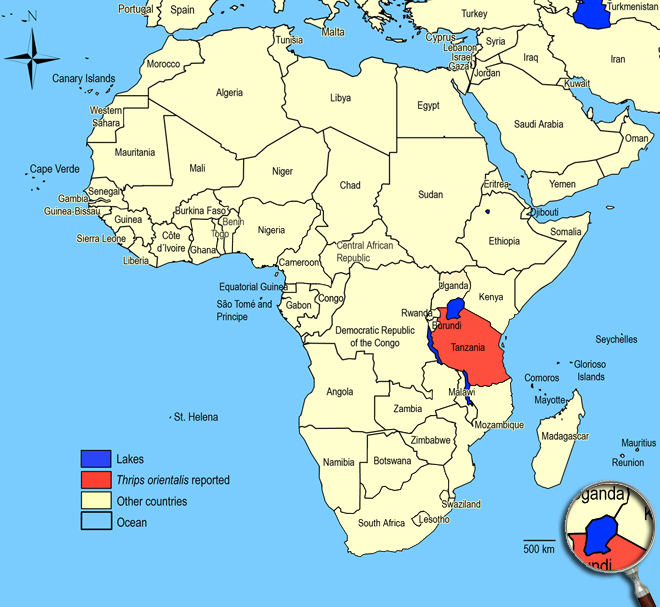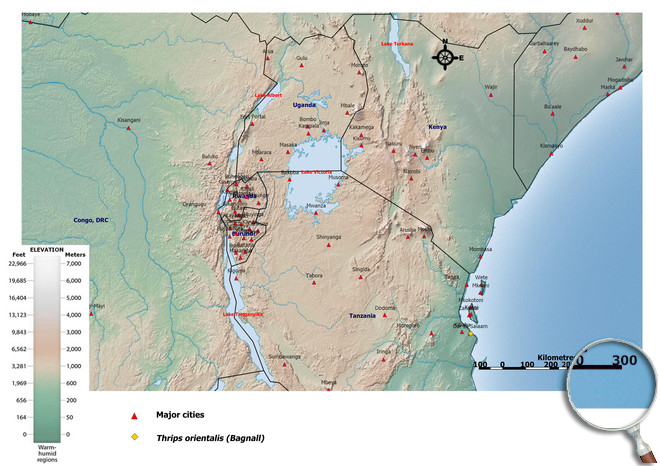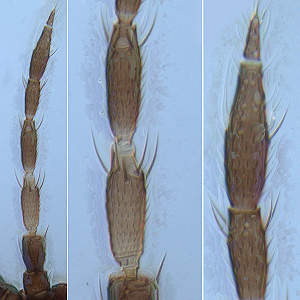Thrips orientalis (Bagnall, 1915)
Thripinae, Thripidae, Terebrantia, Thysanoptera
Figures
Fig. 1: 7-segmented antenna, segments III and IV with forked sense cone, terminal segments V-VII
Fig. 2: Head dorsal with ocellar triangle
Fig. 3: Pronotum
Fig. 4: Meso- and metanotum
Fig. 5: Fore wing and fore wing distal region
Fig. 6: Meso- and metasternum
Fig. 7: Sternites V-VII
Fig. 8: Sternite VII
Fig. 9: Tergites VIII and IX
Introduction and recognition
Thrips orientalis is a polyphagous flower-dwelling thrips, particularly associated with the perfumed white flowers of Jasminum, Gardenia and Plumeria. Both sexes fully winged. Body and legs brown, but tarsi and apices of tibiae yellow; antennal segments III-VII paler than I & II, III mainly yellow, also base of IV & V; fore wings uniformly brown, but with small white spot near veinal fork. Antennae 7-segmented; segments III & IV elongate with apex constricted and forked sense cone (Fig. 1). Head wider than long; with 2 pairs of ocellar setae, pair I absent, pair III small and arising on anterior margins of ocellar triangle; postocular setae I & III about as long as ocellar setae III, postocular setae II minute (Fig. 2). Pronotum with 2 pairs of long posteroangular setae; posterior margin with 3-4 pairs of setae; anterior margin with 3-5 pairs of setae (Fig. 3). Metanotum with mainly equiangular reticulation, reticles with conspicuous internal sculptured markings; median setae longer than lateral setae and arising well behind anterior margin; campaniform sensilla absent (Fig. 4). Mesofurca with spinula (Fig. 6). Mid and hind tarsi 2-segmented. Fore wing first vein highly variable on distal half, from almost complete to only 2 setae medially and 4 distally; second vein with a complete row of setae; clavus with 5 marginal setae, clavus terminal seta shorter than subterminal seta (Fig. 5). Tergite II with 3 lateral marginal setae; V-VIII with ctenidia present laterally, on VIII posteromedial to spiracles; posterior margin of VIII with comb broadly interrupted medially and with a few small microtrichia laterally (Fig. 9); pleurotergites without discal setae. Sternite II with 2 pairs of marginal setae, III-VII with 3 pairs, median marginal setae on VII arising in front of posterior margin; sternites with discal setae variable (0-2 setae on II, but III-VI with 2-6 discal setae placed laterally), discal setae always absent on sternite VII (Fig. 7 and 8).
Male similar to female in structure and color; tergite VIII with no posteromarginal comb; sternites III-VII each with broad transverse glandular area, discal setae often not developed.
Taxonomic identity
Species
Thrips orientalis (Bagnall, 1915)
Taxonomic history
Thrips hispidipennis Hood, 1932
Thrips setipennis Steinweden & Moulton, 1930
Isoneurothrips orientalis Bagnall, 1915
Common name
-
Present taxonomic position
Family: Thripidae Stephens, 1829
Subfamily: Thripinae (Stephens) Karny, 1921
Genus: Thrips Linneaeus, 1758
Genus description
The genus Thrips L., 1758
There are nearly 300 species currently recognized in the genus Thrips making this genus one of the largest taxa within the order Thysanoptera. The genus was redefined progressively during the 1970's (see Mound et al. 1976), to include many species previously placed in Taeniothrips. The genus Thrips now includes a range of species, some with the antennae 7-segmented, others 8-segmented, and a few with the number of segments varying between 7 and 8. Similarly, some species have few setae on the fore wing first vein, whereas others have a complete row of setae on this vein. The species with a complete setal row on the first vein were placed from some taxonomists in the genera Isothrips or Isoneurothrips. However, all of the species in Thrips have the following character states: antennal segments III & IV with forked sense cone, absence of ocellar setae I, pronotum with 2 pairs of elongate posteroangular setae, paired ctenidia laterally on the tergites V-VIII, tergite VIII ctenidium arising posterior to the spiracle (in contrast to species of the genus Frankliniella). Other character states, such as number of antennal segments, number of setae on the fore wing veins, and number of discal setae on the abdominal sternites are variable between species (Mound & Masumoto 2005; Nakahara 1994; Palmer 1992). Identification keys are available for the species of this genus from many parts of the world. Of particular importance is the published key by Mound (2010) for members of the genus Thrips from Afro-tropical region as well as previous Lucid keys from Moritz et al. (2001, 2004, 2009).
Species description
Typical key character states of Thrips orientalis
Coloration and body sculpture
Body color: mainly brown to dark brown
Surface of head, pronotum and fore legs: without obvious or with weakly reticulate sculpture
Antennae
Number of antennal segments: 7
Antennal segment I: without any setae on dorsal apical margin
Antennal segment II: without an exceptionally long seta at the inner apex
Antennal segment II shape: symmetric
Antennal segment III shape: symmetric
Form of sense cones on antennal segments III and IV: emergent and forked on segments III and IV
Length of antennal segment III and IV: antennal segment III similar in length to segment IV
Forked sense cone on antennal segment IV: scarcely extending beyond base of segment V
Antennal segment IV and V: without a hyaline ring near the base
Antennal segment VI bears: not a remarkably dagger-shaped sensorium
Head
Distance between bases of ocellar setae III: greater than width of first ocellus
Head: not prolonged in front of compound eyes
Ocellar setae I: absent
Length of ocellar setae II: shorter than setae III or S2 = S3
Ocellar setae III: arising on anterior margin of, or in front of ocellar triangle
Ocelli: present
Length of postocular setae: not alternating short and long setae
Number of ocellar setae: 2
Prothorax
Number of pairs of anteromarginal minor setae: 3-5
Number of pairs of long anteroangular setae: 0
Number of pairs of long posteroangular setae: 2
Number of pairs of elongate pronotal setae: 2
Number of pairs of posteromarginal minor setae: 3-4
Pronotal blotch or internal apodeme: absent
Pronotum shape: broadly rectangular
Pronotum posteromarginal/posteroangular setae: S2 longer than S3, not equal in length
Mesothorax
Mesosternal furca: with median spinula
Metathorax
Metanotal campaniform sensilla: absent
Reticulations of metanotal sculpture: with many conspicuous internal sculptured markings
Metanotal median setae: S1 behind anterior margin
Metanotum with dominant sculptured triangle medially: absent
Metasternal furca: without spinula
Sculpture of metanotum median area: with mainly equiangular reticulation
Shape of metathoracic furca: transverse, V-shaped
Metanotal median setae length: longer than lateral metanotal setae
Wings
Fore and hind wings: present, more than half as long as abdomen (macropterous)
Fringe cilia arising: from sockets
Fore wing veins: present
Fore- and hind wing surface: covered with microtrichia
Apex of fore wing: with prominent terminal setae
Fore wing anterior margin (costal vein): with setae and cilia but cilia longer than setae
Fore wing clavus - number of marginal setae: 5
Fore wing clavus - terminal veinal seta: shorter than subterminal seta
Fore wing costal fringe cilia: arising at anterior margin of wing
Fore wing first vein: distinct from costal vein
Fore wing second vein setal row: complete, setae uniformly spaced
Fore wing shape: mainly parallel sided or margins run continuously towards each other
Fore wing surface: not reticulate
Fore wing first vein number of setae on distal half: 4-7 (8-9)
Fringe cilia on posterior margin near apex: distinctly wavy (undulated)
Length of fore wing costal setae at middle of wing: longer than half of median wing width
Shape of fore wing apex: with mainly posterior margin curved to join anterior margin
Fore wing extreme apex color: dark
Fore wings: uniformly light brown (rare: uniformly dark or shaded, but with base or sub-base pale
Legs
Fore tibia: not prolonged around fore tarsus
Mid and hind tarsi: with two segments
Color of fore tarsi: pale or yellow, sometimes apical shaded or brown
Abdomen
Pleurotergal discal setae: absent
Pleurotergites: not covered in microtrichia
Number of pleurotergal discal setae: 0
Sternite II: with marginal setae and few or no discal setae
Number of discal setae on sternites III to VI: 2-6
Sternites IV, V and VI: with marginal setae and a few discal setae laterally
Pairs of posteromarginal setae on sternites V and VI: 3
Sternite VII median posteromarginal setae S1: arising in front of posterior margin
Sternite VII: with marginal setae but no discal setae
Surface of lateral thirds of abdominal tergites: without regular rows of fine microtrichia
Number of lateral marginal setae on tergite II: 3
Sculpture of tergites II to VIII: with one or without transverse lines of sculpture between median pair of setae S1
Tergites II to VII median setal pair: no more than 0.3 as long as median length of tergite
Craspedum on tergites IV to VI: absent
Tergites IV and V median setal pair: shorter than distance between their bases
Markings on tergites IV to VI: without shaded areas medially
Tergites V to VII: with ctenidia laterally
Craspedum on tergite VIII: without craspedum medially and toothlike microtrichia laterally
Tergite VIII ctenidia: posteromedial to spiracle
Tergite VIII posteromarginal comb of microtrichia: present laterally, incomplete medially
Color of tergites IX and X: dark or brown
Tergite X: not tubular, longitudinally incomplete
Setae on abdominal tergite X: all setae slender

Similar or related species
Thrips orientalis is very similar to some other Thrips species - like Thrips parvispinus. Thrips orientalis has discal setae on sternites III-VI but not on sternite VII, and no discal setae on pleurotergites (Thrips australis, Thrips microchaetus, Thrips subnudula and Thrips tenellus, all of them have sternites III-VII with at least 1 pair of discal setae and pleurotergites with discal setae; Thrips acaciae, Thrips brevisetosus, Thrips florum, Thrips gowdeyi, Thrips hawaiiensis and Thrips simplex, all of them have sternites III-VII with at least 1 pair of discal setae and pleurotergites without discal setae; Thrips nigropilosus, Thrips palmi, Thrips pusillus and Thrips tabaci, all of them have sternites and pleurotergites without discal setae).
Thrips orientalis differs from Thrips parvispinus in having sternites III-VI with no more than 6 discal setae placed laterally, metanotal equiangular reticulations with many conspicuous internal sculptured markings, brown fore wings only with small white spot near veinal fork, on fore wing clavus the terminal veinal seta is shorter than subterminal seta, and the fore wing first vein is highly variable on distal half, from almost complete to only 2 setae medially and 4 distally. Thrips parvispinus has sternites III-VI with 6-13 discal setae in an irregular row, metanotal equiangular reticulations rarely with faint internal sculptured markings, brown fore wings with base sharply paler, on fore wing clavus the terminal veinal seta is longer than subterminal seta, and the fore wing first vein setal row is complete.
Species of the genus Thrips are similar to species of Stenchaetothrips, Microcephalothrips abdominalis, Larothrips dentipes and Fulmekiola serrata because of tergites V-VIII bear a pair of ctenidia laterally, which is placed on tergite VIII posteromedially to the spiracle, and all species have no ocellar setae I. In contrast to species with craspedum on tergites II-VII (Microcephalothrips abdominalis, Larothrips dentipes and Fulmekiola serrata), species of Thrips and Stenchaetothrips have no posteromarginal craspedum on tergites and sternites. Species of the genus Thrips as well as Fulmekiola serrata and species of Stenchaetothrips have 2 pairs of elongate posteroangular setae (Microcephalothrips abdominalis with 2 pairs of moderately elongate pronotal setae and Larothrips dentipes without elongate setae). Compared to the species of Thrips, Microcephalothrips abdominalis, and Larothrips dentipes, which have ocellar setae II on head much shorter than or about as long as III, Fulmekiola serrata and species of Stenchaetothrips have ocellar setae II much longer than III, and sternites always without discal setae.
Biology
Life history
As with other thrips species the life cycle from egg to adult is dependent on temperature. The full cycle can take about 15 days (Lewis 1973) to over a month. Adults may live for more than one month producing several generations in one year depending on seasons.
Host plants
Particularly associated with the perfumed white flowers of Gardenia, Jasminum and Plumeria.
Vector capacity
None identified, but possible mechanical distribution of phytopathogenic fungi and bacteria.
Damage and symptoms
-
Detection and control strategies
Soil amendments with vermicompost, and foliar application of vemiwash significantly reduced thrips numbers on Jasmine (Meenatchi et al. 2011). Application of 5% Neem Seed Kernal Extract can reduce the thrips numbers.
Additional notes
Feeding and breeding in flowers.
Biogeography
Asia, Australia, Caribbean, Africa. Tanzania (Dar-es-Salaam).
African countries where Thrips orientalis has been reported

Occurence of Thrips orientalis in East Africa

Please click here for survey sites of all observed thrips species of Kenya, Tanzania and Uganda.
Click here for locations of Thrips orientalis in parts of East Africa.

Bibliography
Bagnall RS (1915). Brief descriptions of new Thysanoptera - VI. Annals and Magazine of Natural History, Zoology, Botany and Geology. (Serie 8) 15: 588-597
Bhatti JS (1980). Species of the genus Thrips from India (Thysanoptera). Systematic Entomology. 5 (2): 109-166
Hood JD (1932). New species of the genus Thrips from Central Africa and Egypt. Bulletin de la Société Royale Entomologique ďEgypte. 16/17: 115-140
Karny H (1926). Studies on Indian Thysanoptera. Memoirs of the Department of Agriculture in India, Entomological Series. 9 (6): 187-239
Lewis T (1973). Thrips: their biology, ecology and economic importance. Academic Press Inc., London Ltd., 349 pp
Meenatchi R, Giraddi RS, Patil VS, Vastrad AS & Biradar DP (2011). Effect of vermitechnologies on jasmine insect pests. Karnataka Journal of Agricultural Science 24(3): 312-315.
Moritz G (2006). Thripse. Pflanzensaftsaugende Insekten, Bd. 1, (1. Auflage). Westarp, Hohenwarsleben, 384 pp. ISBN-13: 978 3 89432 891 7
Moritz G, Morris DC & Mound LA (2001). ThripsID - Pest thrips of the world. ACIAR and CSIRO Publishing Collingwood, Victoria, Australia, CDROM ISBN 1 86320 296 X
Moritz G, Mound LA, Morris DC & Goldarazena A (2004). Pest thrips of the world - an identification and information system using molecular and microscopical methods. Centre for Biological Information Technology, University of Queensland, Australia, CDROM ISBN 1 86499 781 8
Moritz G, O'Donnell C & Parrella M (2009). Pest thrips of North America. Centre for Biological Information Technology, University of Queensland, Australia, CDROM ISBN-13: 978 1 86499 940 2
Mound LA (1968). A review of R. S. Bagnalľs Thysanoptera collections. Bulletin of the British Museum (Natural History), Entomology. Supplement 11: 1-181
Mound LA (2010). Species of the genus Thrips (Thysanoptera, Thripidae) from the Afro-tropical Region. Zootaxa. 2423: 1-24
Mound LA & Kibby G (1998). Thysanoptera: An identification guide, (2nd edition). CAB International, Wallingford and New York, 70 pp
Mound LA & Marullo R (1996). The thrips of Central and South America: An introduction (Insecta: Thysanoptera). Memoirs on Entomology, International, Vol. 6. Associated Publishers, Gainsville, 487 pp
Mound LA & Masumoto M (2005). The genus Thrips (Thysanoptera, Thripidae) in Australia, New Caledonia and New Zealand. Zootaxa. 1020: 1-64
Mound LA, Morison GD, Pitkin BR & Palmer JM (1976). Thysanoptera. Handbooks for the identification of British insects, Vol. 1, Part 11. Royal Entomological Society of London, London, 79 pp
Nakahara S (1994). The genus Thrips Linnaeus (Thysanoptera: Thripidae) of the New World. Technical Bulletin, USDA, Agricultural Research Service. 1822: 1-183
Palmer JM (1992). Thrips (Thysanoptera) from Pakistan to the Pacific: a review. Bulletin of the British Museum (Natural History), Entomology. 61 (1): 1-76
Priesner H (1934). Indomalayische Thysanopteren (VI). Natuurkundig Tijdschrift voor Nederlandsch-Indie. 94 (3): 254-290
Reyes CP (1994). Thysanoptera (Hexapoda) of the Philippine Islands. The Raffles Bulletin of Zoology. 42 (2): 107-507
Steinweden JB & Moulton D (1930). Thysanoptera from China. Proceedings of the Natural History Society of the Fukien Christian University. 3: 19-30
zur Strassen R (1980). Thysanopterologische Notizen (5) (Insecta: Thysanoptera). Senckenbergiana Biologica. 60 (3-4): 191-202
----
Web links
Mound´s Thysanoptera pages
Thysanoptera Checklist
ICIPE Thrips survey sites
UNI Halle & Thrips sites
Thrips of California













